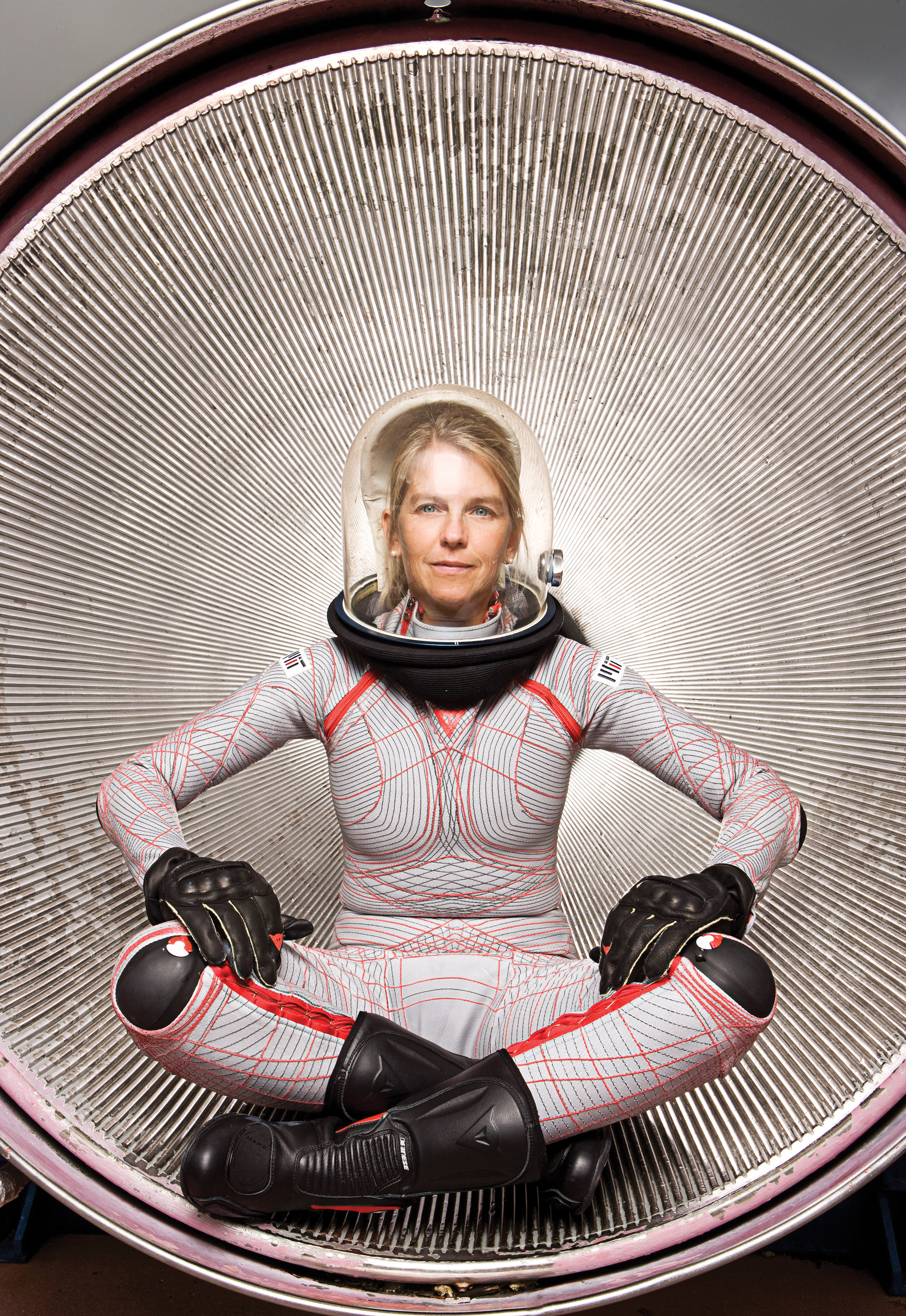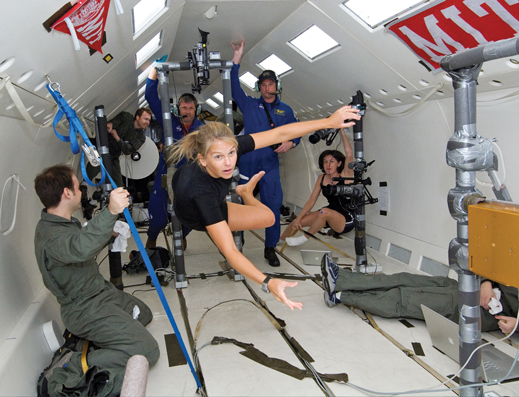Suiting Up

Establishing a human colony on Mars will require exceptional qualities in an explorer, not least of which are ingenuity, a collaborative spirit, and the iron will of a true pioneer. But it will also require a good suit.
MIT’s Dava Newman says colonists will have to be “extreme athlete explorers”—always ready to hop on a rover, climb down a crevasse, or comb through a crater for potential resources. And such physical tasks would be extremely difficult to carry out while wearing traditional heavy, puffy space suits. Today’s suits, which use gas to create the pressure needed in zero gravity, haven’t evolved much since Buzz Aldrin, ScD ’63, and Neil Armstrong made their legendary moonwalk.
“Those were great life-support systems and suits for 40 years ago, but [the astronauts] really couldn’t bend down and take measurements,” says Newman, a professor of aeronautics and astronautics and of engineering systems. “Science wasn’t the purpose then, but if we ever get back to the moon or Mars, it’s all about doing science. You want shirtsleeve mobility, to get as much science as you can out of these pretty hostile environments.”
For the last 15 years, Newman has sought to reinvent the space suit to make it more form-fitting, flexible, and responsive (imagine superhero garb, without the capes). Her lab is engineering several next-generation suits, including the one she’s modeling above: a skintight garment lined with coils of shape-memory alloys that contract to create a pressurized effect in space. She hopes such streamlined suits would give future colonists—whom she sees as similar to the pioneers of the American West—the support and flexibility to actively explore the Martian environment.
Newman’s concept of a “second-skin” space suit “opens the door to incorporating advanced material technologies that can provide functions such as thermal control, energy production, or even artificial photosynthesis to replenish breathing air,” says her colleague David Klaus, associate professor of aerospace engineering sciences at the University of Colorado. Klaus, who studies the design of space suits and spacecraft habitats, believes Newman’s streamlined suit “can revolutionize the way life-support systems are implemented.”

For the next year and a half, Newman’s space-suit research will continue through her former students as she takes a leave of absence from MIT; last fall, President Obama nominated her to be NASA’s deputy administrator, the agency’s second in command. In April, the Senate unanimously confirmed her appointment.
“Spending a couple years of my life very focused on positively impacting the future of space exploration—what a great opportunity,” says Newman, who will oversee NASA’s international partnerships, including the collaboration managing the International Space Station. Newman hopes to significantly contribute to technology, innovation, and education to inspire future aerospace engineers. The agency’s long-term strategic plan, she says, includes sending humans to Mars.
Klaus, who was a finalist as a NASA astronaut candidate and has been instrumental in sending dozens of experiments on the shuttle and the International Space Station, says Newman is more than up to the job. “I am confident that Dava will bring her detailed technical knowledge of human space systems, a strong background in policy, and perhaps most importantly, a true passion and enthusiasm for space exploration to the agency,” he says.
Humans, not weapons, in space
Newman’s interest in space exploration crystallized while she was an undergraduate at the University of Notre Dame in the 1980s, when President Ronald Reagan put forth the Strategic Defense Initiative—a proposal for a space-based missile-defense system intended to guard against a potential Soviet attack. The idea, which would come to be known as “Star Wars,” was a provocative one for Newman, who at the time was taking courses in both aerospace engineering and philosophy.
“For my philosophy term papers, I would write about the technical fallacy of weaponizing space,” she recalls. “I was opposed to [the initiative]. I wanted to think of space as the next frontier for peaceful exploration.”
Writing about space policy motivated Newman to pursue human spaceflight as a research path. At Notre Dame, she was one of two women in her graduating class to receive a degree in aerospace engineering. After graduation and a brief stint at Boeing, she landed at MIT, where she went on to earn two simultaneous master’s degrees (one in aeronautics and astronautics, the other in technology and policy) and a PhD in aerospace biomedical engineering.
In 1993, Newman joined the aero-astro faculty, where she has since led studies to quantify human performance in space. One experiment measured astronauts’ physical and mental performance on the space shuttle. Another examined astronauts’ movement strategies in microgravity aboard the Russian Mir space station. Working with Russian astronauts and engineers for two years was a lesson in cross-border communication.
“We were all after the same research questions, and you could just collaborate seamlessly,” she recalls. “Of course you had funny human moments where you’d be like, ‘Did I understand you? Did you understand me? Can we make sense of the data?’ But it’s a very human level of relating. To this day … even though we live within complicated political systems, engineer to engineer, we all love to work together.”
Newman, who is also a faculty member in the Harvard-MIT Division of Health Sciences and Technology and a Margaret MacVicar Faculty Fellow, encourages just that sort of engineer-to-engineer collaboration across borders as director of MIT’s Portugal Program. And for more than a decade, she has served as director of MIT’s Technology and Policy Program, which educates students on society’s major technological issues and helps them pursue jobs in government and industry.
“In my opinion, it’s absolutely critical that engineers and scientists are involved in developing technologies for the benefit of humanity,” Newman says. “If I truly want to make a difference as an engineer, then I need to understand the sociotechnical and policy environments for my work.”
A 24/7 job
In 2002, Newman authored Interactive Aerospace Engineering and Design, a textbook geared toward students who may be interested in aerospace engineering but don’t quite know how to pursue it.
“I always wished that I had this [textbook] as a freshman deciding what to major in,” she says. “It could help students like me who might be interested and have all the proper background, but just no mentoring or experience with engineering.”
Brad Holschuh, a postdoc in MIT’s Man Vehicle Laboratory, has helped Newman develop smart textiles and active materials for space suits. He says she often goes out of her way to create opportunities for her students to get to know leaders in the aerospace field. “Thanks to Dava, I’ve had the chance to dine with Apollo and shuttle astronauts, to appear in documentaries on both the Discovery Channel and the Science Channel promoting space exploration, and to conduct bioastronautics research on a microgravity parabolic flight,” he says.
“I very much expect our students to change the world.”
Newman’s mentoring extends well beyond the classroom. For the past 11 years, she and her husband, architect Guillermo Trotti, have served as housemasters at MIT’s Baker House, a dorm that houses 330 students.
“It’s 24/7, but boy, what a way to get to know our undergrads—if you live with them, eat with them, and work with them,” Newman says. “I very much expect our students to change the world.” She and Trotti also regularly set up events where students can meet a faculty member or administrator over dinner—an environment that can stimulate what she calls “a different kind of relating.”
Newman’s experience as an athlete helps her relate to many of the students who live in Baker House, which is close to MIT’s athletic facilities. She’s been a Junior Olympic ski racer, a member of Notre Dame’s women’s basketball team, and part of the MIT Strong team that ran the Boston Marathon in 2014. Today, she often gathers teams in the dorm for a healthy meal before a big game.
An Apollo 13 moment at sea
In 2002, she and Trotti embarked on an 18-month round-the-world sailing trip. The couple charted the voyage as a global outreach project, visiting schools in seaside villages to talk with students about space exploration.
“A lot of these kids’ families were in the fishing business, so they knew a lot about exploring the sea,” Newman recalls. “We just made that connection for them, that exploring the sea and space share a whole bunch of the same skills.”
For Newman and Trotti, those skills were put to the test on a particularly harrowing leg of their journey. After their visit to Panama and the Galápagos Islands, they set off on one of the longest crossings of the trip, sailing 3,200 miles to the Marquesas, a chain of islands in the middle of the Pacific. Midway through, Newman found she was unable to steer the boat. She soon discovered the reason: nearly all of the vessel’s hydraulic fluid had leaked through a crack in some copper tubing.
“We were stuck in the middle of the Pacific Ocean, with 1,000 nautical miles to go, so we had to get a fix for the boat to kind of limp in, and then get the proper fix,” she recalls.
To deal with the leak, the couple first needed to replace the lost hydraulic fluid with a liquid of similar viscosity. By a stroke of good fortune, Newman had purchased four liters of olive oil before leaving Panama. As it turned out, the cooking oil was just the right thickness to serve as a stand-in for hydraulic fluid. To repair the crack in the copper tubing, they fitted a rubber hose around it, clamped it down, and used a Tupperware container to collect any leaks. Then they rigged a system of tubes, similar to an IV, to feed the leaked mixture of olive oil and hydraulic fluid back into the tank.
“It really was like our Apollo 13—you’re gonna put a square peg into a round hole somehow, because that’s what you have to deal with,” Newman says. “And boy, when it worked, it was fantastic. We couldn’t believe it—big cheer, and we went across the Pacific on olive oil.”
As NASA’s new deputy, she will be well served by that knack for problem-solving under pressure.
Keep Reading
Most Popular
Large language models can do jaw-dropping things. But nobody knows exactly why.
And that's a problem. Figuring it out is one of the biggest scientific puzzles of our time and a crucial step towards controlling more powerful future models.
The problem with plug-in hybrids? Their drivers.
Plug-in hybrids are often sold as a transition to EVs, but new data from Europe shows we’re still underestimating the emissions they produce.
Google DeepMind’s new generative model makes Super Mario–like games from scratch
Genie learns how to control games by watching hours and hours of video. It could help train next-gen robots too.
How scientists traced a mysterious covid case back to six toilets
When wastewater surveillance turns into a hunt for a single infected individual, the ethics get tricky.
Stay connected
Get the latest updates from
MIT Technology Review
Discover special offers, top stories, upcoming events, and more.